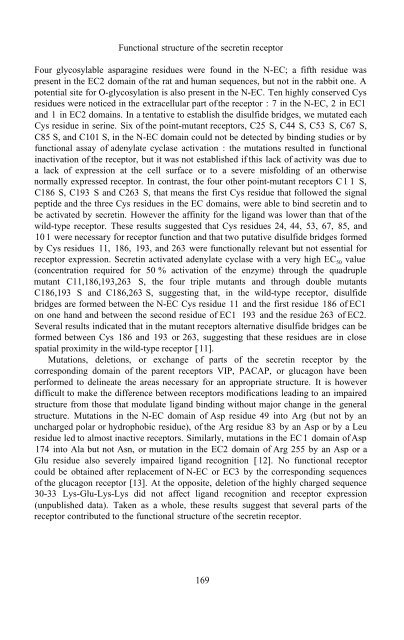Physics And Chemistry Basis Of Biotechnology - De Cuyper - tiera.ru
Physics And Chemistry Basis Of Biotechnology - De Cuyper - tiera.ru
Physics And Chemistry Basis Of Biotechnology - De Cuyper - tiera.ru
You also want an ePaper? Increase the reach of your titles
YUMPU automatically turns print PDFs into web optimized ePapers that Google loves.
Functional st<strong>ru</strong>cture of the secretin receptor<br />
Four glycosylable asparagine residues were found in the N-EC; a fifth residue was<br />
present in the EC2 domain of the rat and human sequences, but not in the rabbit one. A<br />
potential site for O-glycosylation is also present in the N-EC. Ten highly conserved Cys<br />
residues were noticed in the extracellular part of the receptor : 7 in the N-EC, 2 in EC1<br />
and 1 in EC2 domains. In a tentative to establish the disulfide bridges, we mutated each<br />
Cys residue in serine. Six of the point-mutant receptors, C25 S, C44 S, C53 S, C67 S,<br />
C85 S, and C101 S, in the N-EC domain could not be detected by binding studies or by<br />
functional assay of adenylate cyclase activation : the mutations resulted in functional<br />
inactivation of the receptor, but it was not established if this lack of activity was due to<br />
a lack of expression at the cell surface or to a severe misfolding of an otherwise<br />
normally expressed receptor. In contrast, the four other point-mutant receptors C 1 1 S,<br />
C186 S, C193 S and C263 S, that means the first Cys residue that followed the signal<br />
peptide and the three Cys residues in the EC domains, were able to bind secretin and to<br />
be activated by secretin. However the affinity for the ligand was lower than that of the<br />
wild-type receptor. These results suggested that Cys residues 24, 44, 53, 67, 85, and<br />
10 1 were necessary for receptor function and that two putative disulfide bridges formed<br />
by Cys residues 11, 186, 193, and 263 were functionally relevant but not essential for<br />
receptor expression. Secretin activated adenylate cyclase with a very high EC 50 value<br />
(concentration required for 50 % activation of the enzyme) through the quad<strong>ru</strong>ple<br />
mutant C11,186,193,263 S, the four triple mutants and through double mutants<br />
C186,193 S and C186,263 S, suggesting that, in the wild-type receptor, disulfide<br />
bridges are formed between the N-EC Cys residue 11 and the first residue 186 of EC1<br />
on one hand and between the second residue of EC1 193 and the residue 263 of EC2.<br />
Several results indicated that in the mutant receptors alternative disulfide bridges can be<br />
formed between Cys 186 and 193 or 263, suggesting that these residues are in close<br />
spatial proximity in the wild-type receptor [ 11].<br />
Mutations, deletions, or exchange of parts of the secretin receptor by the<br />
corresponding domain of the parent receptors VIP, PACAP, or glucagon have been<br />
performed to delineate the areas necessary for an appropriate st<strong>ru</strong>cture. It is however<br />
difficult to make the difference between receptors modifications leading to an impaired<br />
st<strong>ru</strong>cture from those that modulate ligand binding without major change in the general<br />
st<strong>ru</strong>cture. Mutations in the N-EC domain of Asp residue 49 into Arg (but not by an<br />
uncharged polar or hydrophobic residue), of the Arg residue 83 by an Asp or by a Leu<br />
residue led to almost inactive receptors. Similarly, mutations in the EC 1 domain of Asp<br />
174 into Ala but not Asn, or mutation in the EC2 domain of Arg 255 by an Asp or a<br />
Glu residue also severely impaired ligand recognition [ 12]. No functional receptor<br />
could be obtained after replacement of N-EC or EC3 by the corresponding sequences<br />
of the glucagon receptor [13]. At the opposite, deletion of the highly charged sequence<br />
30-33 Lys-Glu-Lys-Lys did not affect ligand recognition and receptor expression<br />
(unpublished data). Taken as a whole, these results suggest that several parts of the<br />
receptor contributed to the functional st<strong>ru</strong>cture of the secretin receptor.<br />
169












